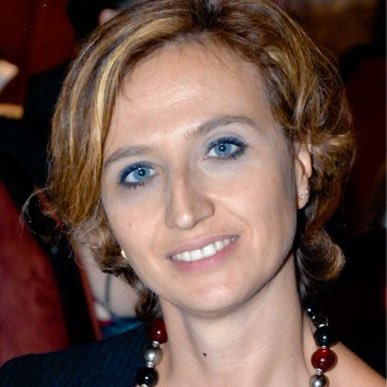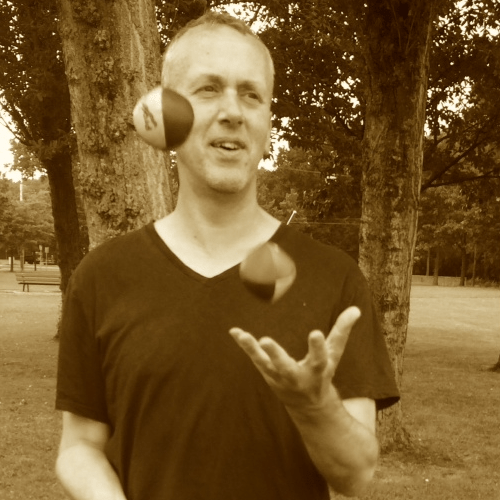Sjoerd Bruijn

Vrije Universiteit Amsterdam
Van der Boechorststraat 9, 1081 BT Amsterdam
room A626
Main interest
My main research interest is how humans are able to walk on two legs with such remarkable ease. I am convinced that this is due to two things; 1) the way the human body is build, and 2) remarkable control from the central nervous system. In my research, I try to disentangle how this control is achieved.
For instance, during my time as postdoc in Leuven, I combined kinematic measures of gait with brain imaging methods, in order to focus on the neural control of gait stability. I designed a gait-related dual-task paradigm combining fMRI and state-of-the-art diffusion tensor imaging (DTI). This project helped to identify (some) gait-related brain areas and corresponding pathways.
Recently, in my NWO-Veni funded project, I’ve used measurements of brain activity during walking, by means of Electro-EncephaloGraphy to see which parts of the brain are involved in making us walk stable on two legs.
Currently, I am starting up and NWO-VIDI project, to follow up on my Veni project. In this project, I will test the hypothesis that gait stability is controlled only in certain moments in the gait cycle. A project page on this project will be online soon.
Other research interests
- I did my internship on the coordination of transverse pelvis and thorax rotations during walking, and continue to have an interest in the coordination of the trunk while walking (see Bruijn et al., 2008; Wu et al., 2008), and am currently supervising a PhD student on this topic.
- Together with Myrthe Plaisier, I’m working on a more applied project, in which we look into the possibility of improving tactile pavement for navigation. Find more details on the project here.
Personal news…
- There are currently no news available
Corporate news…
- There are currently no news available
Research…
Active control and passively stable patterns
Building on research on kinematic measures and neural correlates of gait stability, we hypothesize that several distinct phases of the gait cycle require active control.Neural Underpinnings
Studying motor-related changes of synchronized neural activity and its network-like distribution elucidates how the brain can operate as functional unit despite numerous anatomical connections between simultaneously active neurons.Stability of Gait
Walking on two legs is inherently unstable. Still, we humans perform remarkable well at it, mostly without falling. We measure and perturbed walking to gain more insight into the role of the central nervous system in controlling gait stability.
Network…
- No activities at the moment.
Excerpts of scientific work
- Mapping Trajectories of Gait Recovery in Clinical Stroke Rehabilitation
Mapping Trajectories of Gait Recovery in Clinical Stroke Rehabilitation
Felius, R. A. W., Punt, M., Wouda, N. C., Geerars, M., Bruijn, S. M., Wittink, H. & van Dieën, J. H., Apr 2025, In: Neurorehabilitation and Neural Repair. 39, 4, p. 274-285 12 p.Research output: Contribution to Journal › Article › Academic › peer-review
- The effect of prosthetic alignment on lower limb kinetics in people with a transtibial bone-anchored prosthesis: An experimental within-subject study
The effect of prosthetic alignment on lower limb kinetics in people with a transtibial bone-anchored prosthesis: An experimental within-subject study
Groeneveld, A. M. G., Jonkergouw, N., Bruijn, S. M., Houdijk, H., Kooiman, V. G. M., Leijendekkers, R. A. & Prins, M. R., Mar 2025, In: Gait and Posture. 117, p. 274-282 9 p.Research output: Contribution to Journal › Article › Academic › peer-review
- Predicting community walking after stroke
Predicting community walking after stroke
Felius, R. A. W., Punt, M., Wouda, N. C., Geerars, M., Bruijn, S. M. & van Dieën, J. H., 2025, In: Frontiers in Stroke. 4, p. 1-12 12 p., 1523242.Research output: Contribution to Journal › Article › Academic › peer-review
- The effect of head orientation on vestibular signal-based modulation of paraspinal muscle activity during walking
The effect of head orientation on vestibular signal-based modulation of paraspinal muscle activity during walking
Li, Y. C., Lemaire, K. K., Bruijn, S. M., Brumagne, S. & Dieën, J. H. V., 4 Oct 2024, In: European Journal of Applied Physiology. 125, 2, p. 573-586 888691.Research output: Contribution to Journal › Article › Academic › peer-review
- Are clinical tests and biomechanical measures of gait stability able to differentiate fallers from non-fallers in hereditary spastic paraplegia?
Are clinical tests and biomechanical measures of gait stability able to differentiate fallers from non-fallers in hereditary spastic paraplegia?
van de Venis, L., Ormiston, J., Bruijn, S., Geurts, A. C. H., van de Warrenburg, B. P. C., Weerdesteyn, V., Keijsers, N. & Nonnekes, J., Oct 2024, In: Gait and Posture. 114, p. 270-276 7 p.Research output: Contribution to Journal › Article › Academic › peer-review
- Assessment of stabilizing feedback control of walking: A tutorial
Assessment of stabilizing feedback control of walking: A tutorial
van Dieën, J. H., Bruijn, S. M. & Afschrift, M., Oct 2024, In: Journal of Electromyography and Kinesiology. 78, p. 1-11 11 p., 102915.Research output: Contribution to Journal › Article › Academic › peer-review
- Machine learning approaches to predict whether MEPs can be elicited via TMS
Machine learning approaches to predict whether MEPs can be elicited via TMS
Jin, F., Bruijn, S. M. & Daffertshofer, A., Oct 2024, In: Journal of Neuroscience Methods. 410, p. 1-13 13 p., 110242.Research output: Contribution to Journal › Article › Academic › peer-review
- The Short Physical Performance Battery does not correlate with daily life gait quality and quantity in community-dwelling older adults with an increased fall risk
The Short Physical Performance Battery does not correlate with daily life gait quality and quantity in community-dwelling older adults with an increased fall risk
van Gameren, M., Voorn, P. B., Bossen, D., Hoozemans, M. J. M., Bruijn, S. M., Bosmans, J. E., Visser, B. & Pijnappels, M., Oct 2024, In: Gait & posture. 114, p. 78-83 6 p.Research output: Contribution to Journal › Article › Academic › peer-review
- External Validation and Further Exploration of Fall Prediction Models Based on Questionnaires and Daily-Life Trunk Accelerometry
External Validation and Further Exploration of Fall Prediction Models Based on Questionnaires and Daily-Life Trunk Accelerometry
Zhang, Y., Weijer, R. H. A., van Schooten, K. S., Bruijn, S. M. & Pijnappels, M., Aug 2024, In: Journal of the American Medical Directors Association. 25, 8, p. 1-8 8 p., 105107.Research output: Contribution to Journal › Article › Academic › peer-review
- Force-field perturbations and muscle vibration strengthen stability-related foot placement responses during steady-state gait in healthy adults
Force-field perturbations and muscle vibration strengthen stability-related foot placement responses during steady-state gait in healthy adults
van Leeuwen, A. M., Bruijn, S. M. & Dean, J. C., Aug 2024, In: Human Movement Science. 96, p. 1-25 25 p., 103243.Research output: Contribution to Journal › Article › Academic › peer-review
- The significance of frontal plane static alignment in anticipating dynamic knee moment among transtibial prosthesis users: A cross-sectional study
The significance of frontal plane static alignment in anticipating dynamic knee moment among transtibial prosthesis users: A cross-sectional study
Jonkergouw, N., Sprockel, A. T., Bruijn, S. M., Kooiman, V., Prins, M. R. & Leijendekkers, R. A., Jul 2024, In: Gait and Posture. 112, p. 128-133 6 p.Research output: Contribution to Journal › Article › Academic › peer-review
- Vertebral level specific modulation of paraspinal muscle activity based on vestibular signals during walking
Vertebral level specific modulation of paraspinal muscle activity based on vestibular signals during walking
Li, Y. C., Bruijn, S. M., Lemaire, K. K., Brumagne, S. & van Dieën, J. H., 1 Feb 2024, In: Journal of Physiology. 602, 3, p. 507-525 19 p.Research output: Contribution to Journal › Article › Academic › peer-review
- Beyond gait speed: exploring the added value of Inertial Measurement Unit-based measurements of gait in the estimation of the walking ability in daily life
Beyond gait speed: exploring the added value of Inertial Measurement Unit-based measurements of gait in the estimation of the walking ability in daily life
Felius, R. A. W., Wouda, N. C., Geerars, M., Bruijn, S. M., van Dieën, J. H. & Punt, M., 2024, In: BMC Neurology. 24, p. 1-10 10 p., 129.Research output: Contribution to Journal › Article › Academic › peer-review
- Exploring unsupervised feature extraction of IMU-based gait data in stroke rehabilitation using a variational autoencoder
Exploring unsupervised feature extraction of IMU-based gait data in stroke rehabilitation using a variational autoencoder
Felius, R. A. W., Punt, M., Geerars, M., Wouda, N. C., Rutgers, R., Bruijn, S., David, S. & van Dieen, J., 2024, In: PLoS ONE. 19, 10, e0304558.Research output: Contribution to Journal › Article › Academic › peer-review
- Alterations in stride-to-stride fluctuations in patients with chronic obstructive pulmonary disease during a self-paced treadmill 6-minute walk test
Alterations in stride-to-stride fluctuations in patients with chronic obstructive pulmonary disease during a self-paced treadmill 6-minute walk test
Liu, W. Y., Spruit, M. A., Delbressine, J. M., Willems, P. J., Yentes, J. M., Bruijn, S. M., Franssen, F. M. E., Wouters, E. F. M. & Meijer, K., 2024, In: PLoS ONE. 19, 3, p. 1-12 12 p., e0300592.Research output: Contribution to Journal › Article › Academic › peer-review
- The condition for dynamic stability in humans walking with feedback control
The condition for dynamic stability in humans walking with feedback control
Reimann, H. & Bruijn, S. M., 2024, In: PLoS Computational Biology. 20, 3, p. 1-25 25 p., e1011861.Research output: Contribution to Journal › Article › Academic › peer-review
- Balance training in older adults enhances feedback control after perturbations
Balance training in older adults enhances feedback control after perturbations
Koster, R. A. J., Alizadehsaravi, L., Muijres, W., Bruijn, S. M., Dominici, N. & van Dieën, J. H., 2024, In: PeerJ. 12, 11, p. 1-21 21 p., e18588.Research output: Contribution to Journal › Article › Academic › peer-review
- Mediolateral foot placement control can be trained: Older adults learn to walk more stable, when ankle moments are constrained
Mediolateral foot placement control can be trained: Older adults learn to walk more stable, when ankle moments are constrained
Mahaki, M., van Leeuwen, A. M., Bruijn, S. M., van der Velde, N. & van Dieën, J. H., 2 Nov 2023, In: PLoS ONE. 18, 11 November, e0292449.Research output: Contribution to Journal › Article › Academic › peer-review
- Gait stability and the relationship with energy cost of walking in polio survivors with unilateral plantarflexor weakness
Gait stability and the relationship with energy cost of walking in polio survivors with unilateral plantarflexor weakness
van Duijnhoven, E., van der Veen, M., Koopman, F. S., Nollet, F., Bruijn, S. M. & Brehm, M.-A., 1 Oct 2023, In: Gait and Posture. 107, p. 104-111Research output: Contribution to Journal › Article › Academic › peer-review
- Overlap in the cortical representation of hand and forearm muscles as assessed by navigated TMS
Overlap in the cortical representation of hand and forearm muscles as assessed by navigated TMS
Jin, F., Bruijn, S. M. & Daffertshofer, A., Sept 2023, In: NeuroImage: Reports. 3, 3, p. 1-8 8 p., 100183.Research output: Contribution to Journal › Article › Academic › peer-review
- Trunk Velocity Changes in Response to Physical Perturbations Are Potential Indicators of Gait Stability
Trunk Velocity Changes in Response to Physical Perturbations Are Potential Indicators of Gait Stability
Fallahtafti, F., Bruijn, S., Mohammadzadeh Gonabadi, A., Sangtarashan, M., Boron, J. B., Curtze, C., Siu, K. C., Myers, S. A. & Yentes, J., 1 Mar 2023, In: Sensors. 23, 5, p. 1-15 15 p., 2833.Research output: Contribution to Journal › Article › Academic › peer-review
- A formula for calculating 30-item Geriatric Depression Scale (GDS-30) scores from the 15-item version (GDS-15)
A formula for calculating 30-item Geriatric Depression Scale (GDS-30) scores from the 15-item version (GDS-15)
Zhang, Y., Hoozemans, M., Pijnappels, M. & Bruijn, S. M., Feb 2023, In: Experimental Gerontology. 172, p. 1-3 3 p., 112077.Research output: Contribution to Journal › Article › Academic › peer-review
- The energetic effect of hip flexion and retraction in walking at different speeds: a modeling study
The energetic effect of hip flexion and retraction in walking at different speeds: a modeling study
Jin, J., Kistemaker, D., van Dieën, J. H., Daffertshofer, A. & Bruijn, S. M., 2023, In: PeerJ. 11, 1, p. 1-22 22 p., e14662.Research output: Contribution to Journal › Article › Academic › peer-review
- Does ankle push-off correct for errors in anterior–posterior foot placement relative to center-of-mass states?
Does ankle push-off correct for errors in anterior–posterior foot placement relative to center-of-mass states?
Jin, J., van Dieën, J. H., Kistemaker, D., Daffertshofer, A. & Bruijn, S. M., 2023, In: PeerJ. 11, 5, e15375.Research output: Contribution to Journal › Article › Academic › peer-review
- Effects of vestibular stimulation on gait stability when walking at different step widths
Effects of vestibular stimulation on gait stability when walking at different step widths
Magnani, R. M., van Dieën, J. H. & Bruijn, S. M., Jan 2023, In: Experimental Brain Research. 241, 1, p. 49-58 10 p.Research output: Contribution to Journal › Article › Academic › peer-review
- Mechanisms that stabilize human walking
Mechanisms that stabilize human walking
Van leeuwen, M., Bruijn, S. & Van dieën, J., 15 Dec 2022, In: Brazilian Journal of Motor Behavior. 16, 5, p. 326-351Research output: Contribution to Journal › Article › Academic › peer-review
- Associations between primary motor cortex organization, motor control and sensory tests during the clinical course of low back pain. A protocol for a cross-sectional and longitudinal case-control study
Associations between primary motor cortex organization, motor control and sensory tests during the clinical course of low back pain. A protocol for a cross-sectional and longitudinal case-control study
Klerx, S. P., Bruijn, S. M., Kiers, H., Coppieters, M. W., Twisk, J. W. R. & Pool-Goudzwaard, A. L., 1 Dec 2022, In: Contemporary Clinical Trials Communications. 30, 101022.Research output: Contribution to Journal › Article › Academic › peer-review
- Differential effects of ankle constraints on foot placement control between normal and split belt treadmills
Differential effects of ankle constraints on foot placement control between normal and split belt treadmills
Hos, M., Van iersel, L., Van leeuwen, A. M. & Bruijn, S. M., 1 Nov 2022, In: Journal of Biomechanics. 144, p. 111349 111349.Research output: Contribution to Journal › Article › Academic › peer-review
- Sensor-based intervention to enhance movement control of the spine in low back pain: Protocol for a quasi-randomized controlled trial
Sensor-based intervention to enhance movement control of the spine in low back pain: Protocol for a quasi-randomized controlled trial
Mourits, B. M. P., Vos, L. A., Bruijn, S. M., Dieën, J. H. V. & Prins, M. R., 17 Oct 2022, In: Frontiers in Sports and Active Living. 4, p. 1-11 11 p., 1010054.Research output: Contribution to Journal › Article › Academic › peer-review
- Reliability of IMU-based balance assessment in clinical stroke rehabilitation
Reliability of IMU-based balance assessment in clinical stroke rehabilitation
Felius, R. A. W., Geerars, M., Bruijn, S. M., Wouda, N. C., Van Dieën, J. H. & Punt, M., Oct 2022, In: Gait and Posture. 98, p. 62-68 7 p.Research output: Contribution to Journal › Article › Academic › peer-review
- The effect of external lateral stabilization on ankle moment control during steady-state walking
The effect of external lateral stabilization on ankle moment control during steady-state walking
van Leeuwen, A. M., van Dieën, J. H. & Bruijn, S. M., Sept 2022, In: Journal of Biomechanics. 142, p. 1-5 5 p., 111259.Research output: Contribution to Journal › Article › Academic › peer-review
- Improvement in gait stability in older adults after ten sessions of standing balance training
Improvement in gait stability in older adults after ten sessions of standing balance training
Alizadehsaravi, L., Bruijn, S. M., Muijres, W., Koster, R. A. J. & van Dieën, J. H., Jul 2022, In: PLoS ONE. 17, 7, p. 1-22 22 p., e0242115.Research output: Contribution to Journal › Article › Academic › peer-review
- Gait stability in ambulant children with cerebral palsy during dual tasks
Gait stability in ambulant children with cerebral palsy during dual tasks
Wist, S., Carcreff, L., Bruijn, S. M., Allali, G., Newman, C. J., Fluss, J. & Armand, S., Jun 2022, In: PLoS ONE. 17, 6, p. 1-13 13 p., e0270145.Research output: Contribution to Journal › Article › Academic › peer-review
- Accounting for Stimulations That Do Not Elicit Motor-Evoked Potentials When Mapping Cortical Representations of Multiple Muscles
Accounting for Stimulations That Do Not Elicit Motor-Evoked Potentials When Mapping Cortical Representations of Multiple Muscles
Jin, F., Bruijn, S. M. & Daffertshofer, A., Jun 2022, In: Frontiers in Human Neuroscience. 16, June, p. 1-11 11 p., 920538.Research output: Contribution to Journal › Article › Academic › peer-review
- The effect of constraining mediolateral ankle moments and foot placement on the use of the counter-rotation mechanism during walking
The effect of constraining mediolateral ankle moments and foot placement on the use of the counter-rotation mechanism during walking
van den Bogaart, M., Bruijn, S. M., Spildooren, J., van Dieën, J. H. & Meyns, P., May 2022, In: Journal of Biomechanics. 136, p. 1-8 8 p., 111073.Research output: Contribution to Journal › Article › Academic › peer-review
- Effects of age and surface instability on the control of the center of mass
Effects of age and surface instability on the control of the center of mass
van den Bogaart, M., Bruijn, S. M., Spildooren, J., van Dieën, J. H. & Meyns, P., Apr 2022, In: Human Movement Science. 82, p. 1-10 10 p., 102930.Research output: Contribution to Journal › Article › Academic › peer-review
- Contribution of arm movements to balance recovery after tripping in older adults
Contribution of arm movements to balance recovery after tripping in older adults
Bruijn, S. M., Sloot, L. H., Kingma, I. & Pijnappels, M., Mar 2022, In: Journal of Biomechanics. 133, p. 1-4 4 p., 110981.Research output: Contribution to Journal › Article › Academic › peer-review
- Can foot placement during gait be trained? Adaptations in stability control when ankle moments are constrained
Can foot placement during gait be trained? Adaptations in stability control when ankle moments are constrained
Hoogstad, L. A., van Leeuwen, A. M., van Dieën, J. H. & Bruijn, S. M., Mar 2022, In: Journal of Biomechanics. 134, p. 1-7 7 p., 110990.Research output: Contribution to Journal › Article › Academic › peer-review
- Strong relationship of muscle force and fall efficacy, but not of gait kinematics, with number of falls in the year after Total Hip Arthroplasty for osteoarthritis: An exploratory study
Strong relationship of muscle force and fall efficacy, but not of gait kinematics, with number of falls in the year after Total Hip Arthroplasty for osteoarthritis: An exploratory study
Lin, X. B., Wu, W. H., Weijer, R. H. A., Prins, M. R., van Dieën, J. H., Bruijn, S. M. & Meijer, O. G., Feb 2022, In: Clinical biomechanics (Bristol, Avon). 92, p. 1-7 7 p., 105551.Research output: Contribution to Journal › Article › Academic › peer-review
- The underlying mechanisms of improved balance after one and ten sessions of balance training in older adults
The underlying mechanisms of improved balance after one and ten sessions of balance training in older adults
Alizadehsaravi, L., Koster, R. A. J., Muijres, W., Maas, H., Bruijn, S. M. & van Dieën, J. H., Feb 2022, In: Human Movement Science. 81, p. 1-14 14 p., 102910.Research output: Contribution to Journal › Article › Academic › peer-review
- Reliability of IMU-Based Gait Assessment in Clinical Stroke Rehabilitation
Reliability of IMU-Based Gait Assessment in Clinical Stroke Rehabilitation
Felius, R. A. W., Geerars, M., Bruijn, S. M., van Dieën, J. H., Wouda, N. C. & Punt, M., 1 Feb 2022, In: Sensors. 22, 3, p. 1-19 19 p., 908.Research output: Contribution to Journal › Article › Academic › peer-review
- Stabilization demands of walking modulate the vestibular contributions to gait
Stabilization demands of walking modulate the vestibular contributions to gait
Magnani, R. M., Bruijn, S. M., van Dieën, J. H. & Forbes, P. A., Dec 2021, In: Scientific Reports. 11, 1, p. 1-13 13 p., 13736.Research output: Contribution to Journal › Article › Academic › peer-review
- How does external lateral stabilization constrain normal gait, apart from improving medio-lateral gait stability?
How does external lateral stabilization constrain normal gait, apart from improving medio-lateral gait stability?
Mahaki, M., Ijmker, T., Houdijk, H. & Bruijn, S. M., Mar 2021, In: Royal Society Open Science. 8, 3, p. 1-15 15 p., 202088.Research output: Contribution to Journal › Article › Academic › peer-review
- The validation of new phase-dependent gait stability measures: A modelling approach
The validation of new phase-dependent gait stability measures: A modelling approach
Jin, J., Kistemaker, D., van Dieen, J., Daffertshofer, A. & Bruijn, S., Feb 2021, In: Royal Society Open Science. 8, 2, p. 1-18 18 p., 201122.Research output: Contribution to Journal › Article › Academic › peer-review
- Coordination of axial trunk rotations during gait in low back pain: A narrative review
Coordination of axial trunk rotations during gait in low back pain: A narrative review
van Dieën, J. H., Prins, M. R., Bruijn, S. M., Wu, W. H., Liang, B., Lamoth, C. J. C. & Meijer, O. G., 29 Jan 2021, In: Journal of Human Kinetics. 76, p. 35-50 16 p.Research output: Contribution to Journal › Article › Academic › peer-review
- Ankle muscles drive mediolateral center of pressure control to ensure stable steady state gait
Ankle muscles drive mediolateral center of pressure control to ensure stable steady state gait
Van leeuwen, A. M., Van dieën, J. H., Daffertshofer, A. & Bruijn, S. M., 2021, In: Scientific Reports. 11, p. 1-14 14 p., 21481.Research output: Contribution to Journal › Article › Academic › peer-review
- Active foot placement control ensures stable gait: Effect of constraints on foot placement and ankle moments
Active foot placement control ensures stable gait: Effect of constraints on foot placement and ankle moments
van Leeuwen, A. M., van Dieën, J. H., Daffertshofer, A. & Bruijn, S. M., 17 Dec 2020, In: PLoS ONE. 15, 12, p. 1-19 19 p., e0242215.Research output: Contribution to Journal › Article › Academic › peer-review
- The influence of postural threat on strategy selection in a stepping-down paradigm
The influence of postural threat on strategy selection in a stepping-down paradigm
Kluft, N., Bruijn, S. M., Luu, M. J., Dieën, J. H. V., Carpenter, M. G. & Pijnappels, M., 1 Dec 2020, In: Scientific Reports. 10, 1, p. 9 1 p., 10815.Research output: Contribution to Journal › Article › Academic › peer-review
- Fear of movement is not associated with trunk movement variability during gait in patients with low back pain
Fear of movement is not associated with trunk movement variability during gait in patients with low back pain
Veeger, T. T. J., van Trigt, B., Hu, H., Bruijn, S. M. & van Dieën, J. H., Dec 2020, In: The Spine Journal. 20, 12, p. 1986-1994 9 p.Research output: Contribution to Journal › Article › Academic › peer-review
- Head orientation and gait stability in young adults, dancers and older adults
Head orientation and gait stability in young adults, dancers and older adults
Magnani, R. M., Bruijn, S. M., van Dieën, J. H. & Vieira, M. F., Jul 2020, In: Gait and Posture. 80, p. 68-73 6 p.Research output: Contribution to Journal › Article › Academic › peer-review
Excerpts of scientific work
- Is stability an unstable concept? Quantifying dynamic stability of human locomotion
Is stability an unstable concept? Quantifying dynamic stability of human locomotion
Bruijn, S. M., 2010, 156 p.Research output: PhD Thesis › PhD-Thesis - Research and graduation internal





